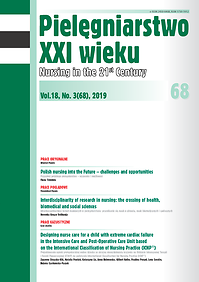The attitude of nursing staff towards the death and dying of the patient
DOI:
https://doi.org/10.2478/pielxxiw-2019-0024Keywords:
patient’s death, nursing staff, attitudes towards deathAbstract
THE ATTITUDE OF NURSING STAFF TOWARDS THE DEATH AND DYING OF THE PATIENT
Introduction. Introduction. Nurses in their work more often than other professional groups have contact with human death. Nowadays, death is the source of many negative emotions that can cause increased exposure to burnout. Therefore, it is extremely important for nursing staff to have an appropriate approach to dying patients, what will allow them to provide optimal care for the patient at the end of his life.
Aim. Assessment of attitudes of nursing staff towards the death and dying of the patient.
Material and methods. The study was conducted using the diagnostic survey method with the use of the original questionnaire, which consisted of 40 questions including 26 questions of single choice, 4 questions of multiple choice and 10 questions with characteristics. The material for the study was collected in March and April 2018, the opinion of 594 registered nurses (581 women, 13 man) was examined in departments where nursing staff have frequent contact with dying patients. The analysis was carried out using the SPSS program.
Results. The most often nursing staff considers death as a natural phenomenon that every human being must meet (52.2%). Most of the nurses approach emotionally (42.3%) to death of patient. The most frequent emotions accompanying members of nursing teams during a patient’s death are compassion (69.4%) and sadness (67.8%). The nursing staff considers that the most ethical treatment for a dying patient is to give him decent conditions of dying (98%). Nurses mainly consider persistent therapy (79.6%) as prolonging suffering.
Conclusions. Nurses in contact with a dying patient most often feel compassion and sadness. The most ethical treatment of a dying patient according to nursing staff is to provide him with decent conditions for dying.
References
1. Major M, Ulman P. Charakterystyka wybranych postaw społecznych w Polsce. Analiza statystyczna. Uniwersytet Ekonomiczny w Krakowie. Zeszyty Naukowe 2011; 847: 5-23.
2. Becler R. Ewolucja operacyjnej definicji śmierci człowieka. Prawo i Medycyna. 2015; 2(59): 17, 52-59.
3. Dangel T, Murawska M, Marciniak W. Pediatryczna domowa opieka paliatywna w Polsce. Medycyna Paliatywna. 2010; 3: 136-138.
4. Sagan M, Pakosz A, Janecki M. Rola opieki paliatywnej w okresie żałoby i osierocenia. Medycyna Paliatywna. 2010; 2,3: 132-136.
5. Miczka-Pajestka M. Śmierć, która nie chce być zobrazowana...? Kulturowe uwarunkowania myślenia o śmierci i śmiertelności a ponowoczesna wizja śmierci. Transformacje. 2016; 1-2 (88-89): 60-72.
6. Krajewska-Kułak E, Mickiewicz I, Łukaszuk C, i wsp. Samoocena postaw pielęgniarek wobec śmierci. Pielęgniarstwo XXI wieku. 2010; 1-2: 43-49.
7. Zawiślak A. Postawy pielęgniarek hospicyjnych wobec śmierci własnej i bliskich osób. Pielęgniarstwo i Zdrowie Publiczne. 2016: 6(3): 197-203.
8. Śleziona M, Krzyżanowski D. Postawy pielęgniarek wobec umierania i śmierci pacjenta. Pielęgniarstwo i Zdrowie Publiczne. 2011: 1(3): 217-223.
9. Niedojad K, Rybka M, Rezmerska L, Ślusarz R. Śmierć i umieranie w opinii personelu pielęgniarskiego. Pielęgniarstwo w Opiece Długoterminowej. 2016; 3: 12-18.
10. Januszewska A, Zarzeka A, Iwanow L, i wsp. Próba analizy poziomu wiedzy i postaw pracowników Kliniki Intensywnej Terapii Instytutu „Pomnika – Centrum Zdrowia Dziecka” wobec prowadzenia uporczywej terapii u dzieci. Pielęgniarstwo Polskie. 2016; 3(61): 389-395.
11. Głowacka M, Haor B, Ślusarz R, i wsp. Śmierć pacjenta jako obciążenie w pracy zawodowej pielęgniarki. Problemy Pielęgniarstwa. 2014; 22(2): 276-280.
12. Ek K, Westin L, Prahl C, et al. Death and caring for dying patients: exploring firstyear nursing students’ descriptive experiences. International Journal of Palliative Nursing. 2014; 20(10): 510-515.
13. Fitch M. Understanding Oncology Nurses. Experiences Talking About Death and Dying. Toronto, Canada. 2014; s. 10-11.
14. Wilson J, Kirshbaum M. Effects of Patient Death on Nursing Staff: A literature review. Sheffield Hallam University Research Archive. 2011; 6-12.
15. Mickiewicz I, Krajewska-Kułak E, Kędziora-Kornatowska K, Rosłan K. Postawy pielęgniarek wobec eutanazji. Pielęgniarstwo i Zdrowie Publiczne. 2011; 1(3): 199-208.
16. Szymańska K. Postawy wobec eutanazji wśród studentów pielęgniarstwa, prawa i kleryków. Pielęgniarstwo i Zdrowie Publiczne. 2012; 2(2): 125-133.
17. Kurleto-Kalitowska E, Romanowska U, Lipińska M, Maj K. Postawy pielęgniarek wobec stosowania uporczywej terapii. Interdyscyplinarne aspekty nauk o zdrowiu. Wyd. Krakowskie Towarzystwo Edukacyjne. 2010; s.155-168.
18. Rui-Shuang Z, Qiao-Hong G, Feng-Qi D, Glynn O. Chinese oncology nurses’ experience on caring for dyingpatients who are on their final days: A qualitative study. International Journal of Nursing Studies. 2015; 52: 288-296.
19. Marcysiak M, Szczepańska E, Ostrowska B, Marcysiak M. Zagrożenie wypaleniem zawodowym wśród pielęgniarek pracujących z terminalnie chorymi. Pielęgniarstwo w Opiece Długoterminowej. 2016; 1, s. 28-37.
Published
Issue
Section
License
Copyright (c) 2019 Authors

This work is licensed under a Creative Commons Attribution-NonCommercial-NoDerivatives 3.0 Unported License.




